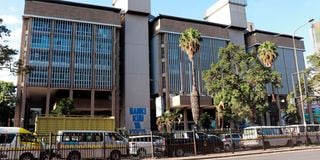Premium
Brace for costlier loans as CBK raises lending rates

Central Bank of Kenya offices in Nairobi.
The Central Bank of Kenya (CBK) has raised the key lending rate in its final policy meeting of the year to tame inflation, marking a second consecutive steep lift and signaling more expensive loans.
The Monetary Policy Committee (MPC), which is the CBK’s top decision-making organ on fiscal policy, on Wednesday raised the Central Bank Rate (CBR) by 50 basis points to 8.75 percent up from 8.25 percent.
This is the first consecutive increase in the base lending rate this year after the CBK raised the rate in September to 8.25 percent up from 7.5 percent. The MPC sits every two months.
CBK Governor Patrick Njoroge said the decision was informed by sustained inflation amid continued global risks that could unleash further negative impacts on the local economy.
“The committee noted the sustained inflationary pressures, the elevated global risks, and their potential impact on the domestic economy and concluded that there was scope for a further tightening of the monetary policy in order to anchor inflation expectations,” said Dr Njoroge.
Inflation hit 9.6 percent in October – the highest level in five years – driven by high food, transport, and household commodities prices.
The last time Kenya’s inflation crossed the current figure was May 2017, when it hit 11.7 percent.
High prices of basic food items such as maize and milk pushed food inflation to 15.8 percent in October from 15.5 percent in September.
The high food prices were attributed to depressed rains and international supply chain disruptions that affected the cost of edible oils and wheat products.
Fuel inflation increased to 12.6 percent in October from 11.7 percent in September, mainly due to the scaling down of the fuel subsidy, increases in electricity prices due to higher tariffs, and increases in transport costs.
The government has fully lifted the subsidy petrol but retained the subsidy on diesel and kerosene with the two fuels key for transport and cooking respectively.
The tightening of the monetary policy in major global economies especially the US has led to the flight of dollars from the local market which has weakened the Kenyan shillings heavily impacting the cost of imports.
“Inflation pressures are showing signs of abating in some major economies, but remain elevated mainly reflecting high energy prices and persistent supply chain challenges,” said Dr Njoroge.
The CBK has tipped the economy to remain strong in the last quarter of 2022, supported by the services sector despite subdued performance in agriculture and weaker global growth.
The raising of the base lending rate is a blow to borrowers by raising interest rates on loan products at a time the cost of living is forcing many households to resort to loans to meet their daily needs.
This saw households borrow Sh213.5 million daily from commercial banks, microfinance banks, and saccos in the nine months to September.
CBK data shows households borrowed Sh58.3 billion from financial institutions between January and September signaling increased demand for loans.
The raising of the base lending rate in May saw the cost of loans from commercial banks hit 12.38 percent in August which is the highest rate since November 2019.
The average rate of loans from commercial banks rose further to 12.41 percent in September.





